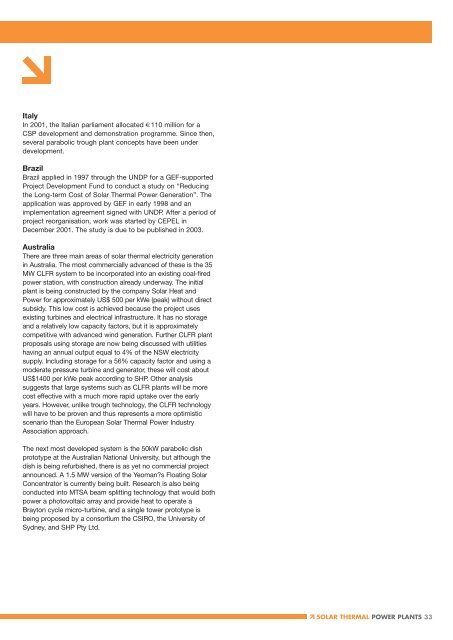solar thermal power - Greenpeace
solar thermal power - Greenpeace
solar thermal power - Greenpeace
You also want an ePaper? Increase the reach of your titles
YUMPU automatically turns print PDFs into web optimized ePapers that Google loves.
Italy<br />
In 2001, the Italian parliament allocated €110 million for a<br />
CSP development and demonstration programme. Since then,<br />
several parabolic trough plant concepts have been under<br />
development.<br />
Brazil<br />
Brazil applied in 1997 through the UNDP for a GEF-supported<br />
Project Development Fund to conduct a study on “Reducing<br />
the Long-term Cost of Solar Thermal Power Generation”. The<br />
application was approved by GEF in early 1998 and an<br />
implementation agreement signed with UNDP. After a period of<br />
project reorganisation, work was started by CEPEL in<br />
December 2001. The study is due to be published in 2003.<br />
Australia<br />
There are three main areas of <strong>solar</strong> <strong>thermal</strong> electricity generation<br />
in Australia. The most commercially advanced of these is the 35<br />
MW CLFR system to be incorporated into an existing coal-fired<br />
<strong>power</strong> station, with construction already underway. The initial<br />
plant is being constructed by the company Solar Heat and<br />
Power for approximately US$ 500 per kWe (peak) without direct<br />
subsidy. This low cost is achieved because the project uses<br />
existing turbines and electrical infrastructure. It has no storage<br />
and a relatively low capacity factors, but it is approximately<br />
competitive with advanced wind generation. Further CLFR plant<br />
proposals using storage are now being discussed with utilities<br />
having an annual output equal to 4% of the NSW electricity<br />
supply. Including storage for a 56% capacity factor and using a<br />
moderate pressure turbine and generator, these will cost about<br />
US$1400 per kWe peak according to SHP. Other analysis<br />
suggests that large systems such as CLFR plants will be more<br />
cost effective with a much more rapid uptake over the early<br />
years. However, unlike trough technology, the CLFR technology<br />
will have to be proven and thus represents a more optimistic<br />
scenario than the European Solar Thermal Power Industry<br />
Association approach.<br />
The next most developed system is the 50kW parabolic dish<br />
prototype at the Australian National University, but although the<br />
dish is being refurbished, there is as yet no commercial project<br />
announced. A 1.5 MW version of the Yeoman?s Floating Solar<br />
Concentrator is currently being built. Research is also being<br />
conducted into MTSA beam splitting technology that would both<br />
<strong>power</strong> a photovoltaic array and provide heat to operate a<br />
Brayton cycle micro-turbine, and a single tower prototype is<br />
being proposed by a consortium the CSIRO, the University of<br />
Sydney, and SHP Pty Ltd.<br />
SOLAR THERMAL POWER PLANTS 33

















